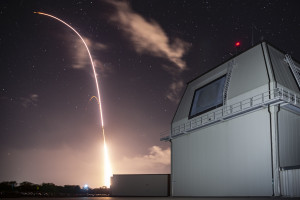Most of the Missile Defense Agency’s (MDA) flight tests planned for fiscal years 2020 and 2021 will be affected by Defense Department measures to prevent the spread of the COVID-19 pandemic, the agency said this week.
MDA spokeswoman Heather Cavaliere told Defense Daily in an email that due to COVID-19 MDA has either canceled or rescheduled 19 outreach events so far and other events may be affected as well. The agency “is continuing to analyze the impacts to upcoming scheduled flight tests and other MDA processes and events.”

Cavaliere said some flight tests were postponed to be in “full alignment” with DoD guidance on travel and shipment restrictions.
“The majority of flight tests planned for FY ’20 and FY ’21 will be affected by the mandated DoD travel restrictions necessary to prevent the spread of
COVID-19,” Cavaliere said.
MDA plans to keep the planned tests as close as possible to the original dates while trying to stay consistent with and best meet DoD COVID-19 measures, congressional direction, DoD priorities and warfighter requests “with minimal delays.”
The first live fire test affected so far is FTM-44, which has been officially postponed from the spring “and will now take place at a later date yet to be determined,” Cavaliere said. The event aims to test the Aegis Weapons System’s capability to defeat an intercontinental ballistic missile (ICBM) threat-representative target using a Standard Missile-2 (SM-2) Block IIA in a Hawaii defense scenario.
Recently at the Hudson Institute, Deputy Assistant Secretary of Defense for Nuclear and Missile Defense Policy Robert Soofer said the department was looking to conduct an SM-3 IIA intercept test against a North Korean-representative ICBM threat “probably in the summer timeframe” (Defense Daily, April 22).
This test is seeing if the Aegis and SM-3 IIA systems can be used as an underlayer to add in addition to the Ground-based Midcourse Defense system’s Ground-Based Interceptors (GBI), geared to defend the U.S. from a small number of ballistic missiles from a threat like North Korea. DoD is looking at options to supplement the GBIs after the Redesigned Kill Vehicle was canceled and replaced with the Next Generation Interceptor.
SM-3 was designed as a regional missile defense system to intercept medium-range ballistic missiles in the midcourse phase of flight with the Block IIA version, a cooperative U.S.-Japan program to increase its speed and range.
“If the SM-3 IIA is capable of intercepting a North Korean-representative ICBM threat, this opens up some possibility to use the SM-3 IIA as an underlay to the GMD system,” Soofer said.